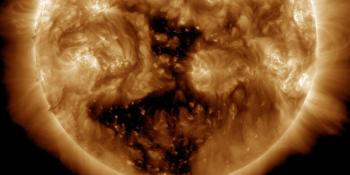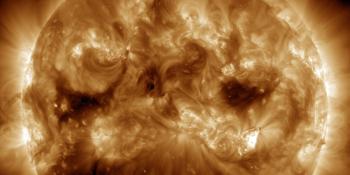Viewing archive of Sunday, 4 August 2002
Solar activity report
Any mentioned solar flare in this report has a scaling factor applied by the Space Weather Prediction Center (SWPC). Because of the SWPC scaling factor, solar flares are reported as 42% smaller than for the science quality data. The scaling factor has been removed from our archived solar flare data to reflect the true physical units.
Report of Solar-Geophysical Activity 2002 Aug 04 2200 UTCPrepared by the NOAA © SWPC and processed by SpaceWeatherLive.com
Joint USAF/NOAA Report of Solar and Geophysical Activity
SDF Number 216 Issued at 2200Z on 04 Aug 2002IA. Analysis of Solar Active Regions and Activity from 03-2100Z to 04-2100Z
Solar activity was high due to a long duration M6 x-ray
event at 0955 UTC. The event was associated with activity behind the
southwest limb in cotemporaneous solar image data. A faint CME could
be seen in LASCO images associated with the flare with an
approximate plane-of-sky speed of 500 km/s. The CME does not appear
to have any earthward component. The remainder of today's solar
activity consisted of occasional C-class flares. With the departure
of Regions 39, 44, and 50, Region 57 is now the dominant sunspot
group on the disk. Region 57 has shown growth over the past 24 hours
and possesses some magnetic complexity. The group produced
occasional subflare activity.
IB. Solar Activity Forecast
Solar activity is expected to be
mostly moderate over the next three days. There is a very slight
chance, however, that one of the regions behind west limb could
produce another major flare or proton producing event. Of the
regions on the disk, Region 57 shows the best potential for
producing an M-class event.
IIA. Geophysical Activity Summary 03-2100Z to 04-2100Z
The geomagnetic field ranged from quiet to minor storm levels. A
period of moderately negative Bz in the solar wind occurred from
about 2300-0300 UTC and led to active to minor storm conditions from
0000-0900 UTC. The source of the enhanced Bz is uncertain, but may
be related to a solar sector boundary crossing from towards
orientation to an away orientation which occurred during the past 24
hours.
IIB. Geophysical Activity Forecast
The geomagnetic field is
expected to be mostly unsettled for the next three days. There is a
possibility, however, for some isolated active periods on the third
and fourth days as a coronal hole will be rotating into favorable
position at that time.
III. Event Probabilities 05 Aug to 07 Aug
| Class M | 50% | 45% | 45% |
| Class X | 10% | 05% | 05% |
| Proton | 10% | 05% | 05% |
| PCAF | green | ||
IV. Penticton 10.7 cm Flux
Observed 04 Aug 151 Predicted 05 Aug-07 Aug 150/145/145 90 Day Mean 04 Aug 167
V. Geomagnetic A Indices
Observed Afr/Ap 03 Aug 011/020 Estimated Afr/Ap 04 Aug 015/015 Predicted Afr/Ap 05 Aug-07 Aug 010/010-010/010-012/015
VI. Geomagnetic Activity Probabilities 05 Aug to 07 Aug
| A. Middle Latitudes | |||
|---|---|---|---|
| Active | 25% | 25% | 35% |
| Minor storm | 15% | 15% | 20% |
| Major-severe storm | 05% | 05% | 05% |
| B. High Latitudes | |||
|---|---|---|---|
| Active | 30% | 30% | 35% |
| Minor storm | 15% | 15% | 20% |
| Major-severe storm | 05% | 05% | 10% |
All times in UTC
Current data suggests there is a slight possibility for aurora to appear at the following high latitude regions in the near future
Norilsk, VorkutaLatest news
Latest forum messages
Large Coronal Hole 25 153AR4043 20Aurora photography hints for those of us with smartphones 45Incoming & Unnumbered Active Regions 1644Photographing auroras 36
More topicsSupport SpaceWeatherLive.com!
A lot of people come to SpaceWeatherLive to follow the Sun's activity or if there is aurora to be seen, but with more traffic comes higher server costs. Consider a donation if you enjoy SpaceWeatherLive so we can keep the website online!

Latest alerts
16:15 UTC - Geomagnetic activity
Minor G1 geomagnetic storm (Kp5) Threshold Reached: 16:05 UTC
15:15 UTC - Geomagnetic activity
Minor G1 geomagnetic storm (Kp5) Threshold Reached: 14:59 UTC
09:15 UTC - Geomagnetic activity
Minor G1 geomagnetic storm (Kp5) Threshold Reached: 08:59 UTC
06:27 UTC - Hemispheric Power Index
The OVATION model predicts the Hemispheric Power Index to reach 54GW at 07:01 UTC
06:00 UTC - Geomagnetic activity
Minor G1 geomagnetic storm (Kp5) Threshold Reached: 05:51 UTC
Space weather facts
| Last X-flare | 2025/02/23 | X2.0 |
| Last M-flare | 2025/03/27 | M2.0 |
| Last geomagnetic storm | 2025/03/26 | Kp6+ (G2) |
| Spotless days | |
|---|---|
| Last spotless day | 2022/06/08 |
| Monthly mean Sunspot Number | |
|---|---|
| February 2025 | 154.6 +17.6 |
| March 2025 | 132.3 -22.3 |
| Last 30 days | 131.2 -21.8 |





